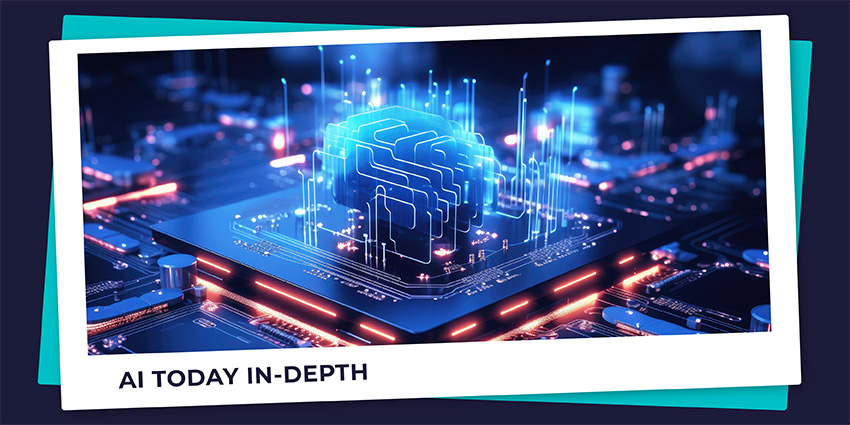You’ve probably already heard of AI (artificial intelligence), but what is AGI in artificial intelligence, and what does it mean for the future of technology?
AGI, otherwise known as “Artificial General Intelligence”, has been a hot topic for computer scientists and tech enthusiasts for years now. In fact, although the term AGI was first coined in 2007, discussions about the theoretical concept of AGI date back to the late 1990s.
On a broad scale, AGI represents the future of AI, imagining an environment where intelligent machines can think, reason, and operate with human-level intelligence.
Here, we’ll introduce you to what AGI is, how it could work, and the benefits and risks of developing artificial general intelligence.
What is AGI in Artificial Intelligence?
AGI (Artificial General Intelligence) is a theoretical field of AI research focused on creating software with human-like intelligence and the ability to self-teach. Essentially, AGI systems would replicate human-like cognitive capabilities linked to problem-solving, reasoning, and perception.
We say would here because AGI doesn’t actually exist – at least not yet. Today’s AI solutions have become increasingly advanced. Generative and conversational AI can seemingly understand human language, intent, and sentiment, and even produce highly creative content.
However, these systems aren’t examples of AGI. A core facet of artificial general intelligence is that it would make a machine’s cognitive abilities indistinguishable from those of a human. AGI tools would be able to pass the “Turing test”, understand, communicate, and act with the same abilities as a human being. On a high level, AGI systems would essentially be able to think.
They would understand the world and themselves, be able to solve complex problems like humans do, and learn from their experiences, without the need to rely on constant training.
The Difference Between AGI and AI
Thanks to rapid evolutions in AI technology, AGI might not seem very far away. But there’s a significant difference between AI and AGI. Standard AI solutions (the tools we can access today), are forms of “narrow” or “weak” artificial intelligence.
These solutions can seem incredibly powerful, but they actually just excel at completing specific tasks, or addressing certain problems. Many AI systems use a range of algorithms, from machine learning and deep learning, to natural language processing, to perform specific tasks.
These technologies are highly versatile and adaptable and can be tuned to a range of use cases. For instance, we already have customer service chatbots, recommendation engines used by companies like Google and Netflix, and image and facial recognition algorithms.
However, none of these tools possess true human cognitive abilities – not even generative AI.
We’ve seen generative AI accomplish incredible things in recent years, from writing software code to composing sonnets. However, these tools don’t have artificial general intelligence.
Essentially, they’re just incredibly advanced “prediction” machines. They use the data they have to predict (often with a high degree of accuracy), how they should respond to a specific prompt. All of the AI solutions we have today, from image recognition systems to generative AI bots, rely on statistics, algorithms, and data. They don’t possess human capabilities like logical reasoning and sensory perception.
In contrast, AGI tools would feature genuine cognitive and emotional abilities similar to a human. They’d be able to understand the meaning behind what they’re doing, demonstrate empathy, and learn new skills without human input.
AGI should, theoretically be able to perform any task a human can perform, and exhibit a range of different types of intelligence.
What Can AGI in Artificial Intelligence Do?
Ultimately, it’s difficult to define exactly what AGI will be able to do, because it’s still just a theory. No true AGI systems exist – at least not yet. However, computer scientists and analysts theorize that the potential for AGI systems would be extremely vast.
True AGI solutions would be capable of executing human-level tasks, and have abilities that current computers simply can’t possess. They’d be able to use abstract thinking, background knowledge, and common sense when completing tasks. These tools would demonstrate a new level of creativity too.
Unlike generative AI models which replicate creativity by “predicting” what should come next in a sequence, an AGI system would be able to read and understand information, and create content with a high level of empathy, emotional intelligence, and intuition.
Examples of AGI’s Potential in Various Industries
AGI tools would build on the AI solutions we already have, such as supercomputers, expert systems, and generative pre-trained transformers to unlock new use cases. For instance, here are some examples of what AGI systems may be able to do in different industries.
- Healthcare: AGI would be able to analyze huge amounts of patient data, identify issues with patients, understand future diseases, and even design personalized treatment strategies.
- Education: Artificial general intelligence would be able to create a unique curriculum for every student and provide step-by-step emotionally intelligent guidance to students.
- Customer service: AGI could use demographic and historical data to tailor service delivery for each customer and even proactively address issues before they occur.
- Finance: Artificial general intelligence would be able to enhance financial modeling accuracy, predict market behavior, and automate trading processes.
- Automotive: AGI would power the future of autonomous cars, collecting real-time information from sensors and making instant adjustments in various scenarios.
- Programming: Unlike generative AI, AGI would be able to understand coding logic, allowing it to make recommendations and design functions in the programming space.
- Manufacturing: With AGI, manufacturing teams could analyze vast amounts of data to predict machine issues, and even implement fixes before breakdowns occur.
What is AGI in Artificial Intelligence? Theoretical Approaches
As mentioned above, AGI has yet to become a reality. Although organizations like OpenAI and Microsoft claim that solutions like GPT-4 exhibit “near” human-level intelligence, we’re still stuck in the age of “narrow AI”. To progress to “strong AI”, and AGI, innovators are investing in various types of research, such as:
The Symbolic Approach
The symbolic approach to enabling AGI assumes that computer systems can develop human intelligence by representing “thought processes” with advanced logic networks. Logic networks would allow systems to process data using methodologies that replicate the workings of the human brain with “if-else” logic.
Although this process would allow an AI system to interpret ideas more effectively, it can’t fully replicate subtler cognitive abilities, such as perception.
The Connectionist Approach
Otherwise known as the “emergentist” approach, the connectionist approach, builds on some of the strategies already used by AI innovators to give computers their own “brain”. It focuses on using the neural network architecture to simulate neurons in a brain.
Just as neurons in a human brain change how they transmit data based on how we interact with external stimuli, advanced neural networks would enable the same approach for machines. Large language models already use the “connectionist method” to enable deep levels of language understanding. However, further research would be necessary to fully replicate the workings of the human brain in a neutral network.
The Universalist and Whole Organism Approach
Researchers investing in the “universalist” approach to AGI development look at addressing the complexities of “machine thinking” on a calculation level. They’re attempting to formulate theoretical solutions that would allow machines to overcome thinking limitations.
On the other hand, whole organism architecture researchers look beyond simple “human thinking” to integrate AI models with a representation of the human body. Scientists focusing on this landscape believe machines need to be able to learn from physical interactions.
The Technologies Powering AGI Development
While AGI might still be a theoretical concept, we’re already developing the technologies we need to make human-level intelligence possible in machines. Already we have various LLMs, self-driving car systems, and other tools that can demonstrate certain aspects of AGI.
The future of AGI will depend on a combination of new yet-undiscovered technologies and existing solutions, such as:
- Deep learning: Deep learning is a discipline in AI that involves training neural networks with various hidden layers that enable systems to understand relationships in raw data. Deep learning allows for developing AI tools that understand text, audio, video, images, and various other forms of information.
- Generative AI: A subset of deep learning, generative AI allows systems to produce unique content based on their existing knowledge. These models train with massive data sets, allowing them to create content similar to human beings. Many experts believe the rise of generative AI will accelerate the creation of AGI models.
- Advanced computing systems: Enhanced GPUs (Graphics Processing Units), enable AI systems to process and transfer data faster. However, further evolutions will be necessary to enable full AGI systems. Quantum computing, for instance, may open the door to more powerful, intuitive computer systems.
- NLP and computer vision: Natural language processing and computer vision technologies empower machines to draw insights from voice, human language, and images. They empower systems to understand more of the data around them and demonstrate a certain level of situational awareness, which is crucial for AGI.
- Robotics: In AGI, robotics systems will enable machine intelligence to manifest on a physical level. It will allow developers to give AGI systems the sensory perception and physical manipulation capabilities they need to replicate human beings in various environments.
The Benefits of AGI in Artificial Intelligence
Just like other AI evolutions, artificial general intelligence could revolutionize the world as we know it. Although the use cases for AGI have yet to be fully realized, most computer scientists and researchers agree this technology will lead to:
- Increased productivity: AGI will enhance productivity in ways that go beyond the capabilities of today’s narrow AI systems. They’ll be able to rapidly adapt to new tasks and roles, handling various challenges with human-level intelligence.
- Enhanced problem-solving: The advanced computing power in AGI systems could help humans address a range of complex problems, from climate change to issues with supply chains and even disease management.
- Improved interactions with machines: Already, many of us use AI systems as assistants and sources of support in our everyday lives. However, AGI will be able to offer recommendations, suggestions, and guidance with emotional intelligence and empathy.
- Greater creativity: AGI could use its flexible thinking capabilities to craft everything from novels and songs to movie scripts and programs with very little prompting. It would allow us to create and share more content than ever before.
- Optimized machines: As mentioned above, AGI would allow us to create cars that can drive themselves, machines that can build products more efficiently, and robots that can offer a human level of service and support to customers.
The Problems with AGI in Artificial Intelligence
Of course, as beneficial as AGI could be for society, it also presents some significant risks. Already, artificial intelligence is changing our perception of the world, introducing new security threats, and influencing how we think about ethics.
If we create AI systems capable of thinking and acting like humans, new problems will undoubtedly emerge. We’ll need to carefully consider how these AI systems will be governed and whether they’ll be subject to the same rules and ethical standards as human beings. New strategies will need to be implemented to ensure AI systems operate safely, and aren’t used for malicious purposes.
On top of that, there’s a risk that advanced AGI solutions will further displace the need for human beings in various industries. AI systems that could mimic and surpass human abilities would potentially make billions of human workers obsolete.
Plus, it’s safe to say strong AI may still suffer from some of the same issues faced by narrow AI systems, such as bias caused by training with incomplete data, and AI hallucinations.
The Future of Artificial General Intelligence
There’s still much work to be done before “artificial general intelligence” becomes a reality. Some experts believe we’re edging ever closer to the age of AGI, predicting the first instances of these systems will begin to appear by 2030. Others believe it will be decades before AGI emerges.
It’s safe to say that we’re making progress. Google Deepmind’s AlphaGeometry 2 has already been championed as a “milestone” development in AGI creation. Companies like OpenAI are also making progress toward AI systems that appear to replicate human reasoning.
If AGI is ever realized, it would mean developing AI systems that could act on common sense and abstract thinking processes and understand cause and effect. This would open up endless possibilities for innovation in virtually every industry.
On the other hand, the development of AGI will lead to significant issues to overcome. We’re still in the process of developing ethical and governance frameworks for narrow AI solutions like generative AI. The process of implementing the right frameworks to govern AGI would be even more complex, requiring global collaboration and the development of new laws.
However, whether you’re excited about the future of AGI, or just concerned, it’s safe to say the concept of AGI will continue to attract attention in the years to come.








